
Table of Contents
What is Remote Work?

Remote working is like bringing your job to your living room, your favorite coffee shop, or even your backyard. Instead of going to a traditional office every day, you get to work from wherever you feel most comfortable and productive.
Imagine waking up, grabbing your laptop, and starting your workday without ever leaving your home. That’s remote working! It’s like taking your office with you, but minus the commute and the office dress code. You can still connect with your team and get things done, but you have the freedom to choose your workspace.
Whether you’re in your pajamas or sipping coffee at your favorite spot in town, as long as you have an internet connection, you’re good to go. It’s a bit like bringing your workplace to your personal space, making your work life more flexible and, let’s be honest, a lot more comfortable!
What are the Different Types of Challenges you can Face while Doing Remote Work:

Remote work comes with its share of perks, but it also has its challenges. Here are some common difficulties you might face:
1. Communication Hurdles:
– Lack of Face-to-Face Interaction: Without the ability to have spontaneous face-to-face conversations, there’s a risk of misinterpretation or missing non-verbal cues. Video calls can help bridge this gap.
– Time Zone Differences: Coordinating with team members in different time zones requires careful planning to ensure effective communication and collaboration.
2. Work-Life Balance:
– Boundary Blur: When your home becomes your workplace, it’s essential to establish clear boundaries. Designate specific work hours and physical spaces for work to prevent work from infiltrating personal time.
3. Technology Issues:
– Internet Problems: Unstable or slow internet connections can disrupt your workflow. Consider having a backup plan, such as a mobile hotspot, to maintain connectivity during outages.
– Hardware/Software Compatibility: Ensure that your home devices are compatible with the tools and software used for work. Regular updates and troubleshooting can help prevent technical disruptions.
4. Isolation and Loneliness:
– Missing Office Culture: The absence of daily interactions with colleagues may lead to feelings of loneliness. Regular virtual team meetings, informal chats, and team-building activities can help maintain a sense of connection.
5. Self-Motivation:
– Procrastination: Without the structure of a traditional office, it’s easy to succumb to procrastination. Set a daily routine, break tasks into smaller goals, and use productivity tools to stay on track.
6. Security Concerns:
– Cybersecurity: Working outside the office network may expose you to potential security risks. Use secure networks, update your antivirus software, and be cautious with sharing sensitive information. Adhering to company security protocols is crucial in a remote setting.
We have talked about what are the difficulty you will be facing while doing remote work but now let’s talk about what will the benefits you will be getting in remote work
6 Perks of Remote Working:

1. Flexibility and Work-Life Balance:
– Customizable Schedule: Remote work allows you to tailor your work hours to your most productive times, fostering a better work-life balance. You can attend to personal matters without compromising work commitments.
2. Reduced Commute Stress and Costs:
– No Commute: The elimination of daily commutes saves you time, reduces stress, and lowers transportation costs. This not only adds hours to your day but also contributes to a more sustainable lifestyle.
3. Increased Productivity:
– Personalized Work Environment: Designing your own workspace at home can enhance focus and productivity. You have the freedom to create an environment that suits your preferences and work style.
4. Access to a Global Talent Pool:
– Wider Talent Pool: Companies can tap into a diverse range of talent globally without being limited by geographical boundaries. This opens up opportunities for collaboration with professionals from various backgrounds and experiences.
5. Cost Savings:
– Reduced Expenses: Working remotely often leads to savings on commuting, work attire, and daily meals. Employers can also benefit from reduced overhead costs associated with maintaining a physical office space.
6. Improved Work-Life Integration:
– Balanced Personal and Professional Life: Remote work allows for better integration of personal and professional life. Whether it’s attending family events, managing household responsibilities, or pursuing personal interests, remote work provides the flexibility to accommodate these aspects more seamlessly.
Opting remote work not only enhances your personal well-being but also contributes to a more adaptable and inclusive work culture. It’s important to leverage the advantages of remote work while being mindful of maintaining effective communication and collaboration with your team.
Let’s Consider 20 Remote Work Tools which boost up your Productivity:
1. Communication Tools – Slack:
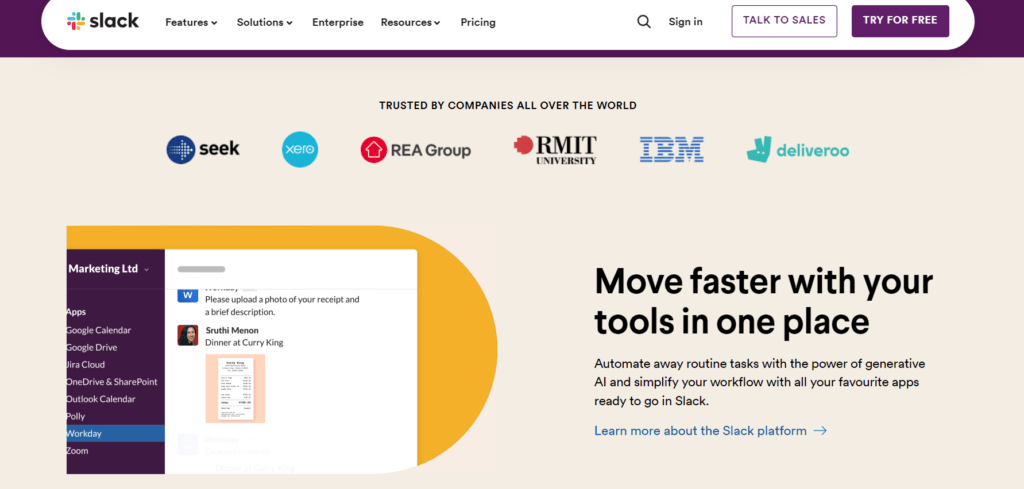
Slack is a robust communication tool designed to streamline and enhance team collaboration in a remote or distributed work environment. With its user-friendly interface and real-time communication features, Slack has become the go-to for businesses looking to improve communication.
Essentially, Slack provides a platform where team members can communicate instantly through channels organized by project, team or topic. This structure ensures that conversations remain focused and easily accessible, reducing the clutter often associated with traditional email communication. Channels can be public for broad discussions or private for sensitive matters, providing flexibility in communication dynamics.
One of Slack’s strengths lies in its integrations. It seamlessly integrates with many third-party applications and services, allowing teams to centralize data and workflows. From file sharing to project management tools, these integrations reduce the need for constant app-switching, fostering a more cohesive and productive work environment.
Slack’s notification system is another key feature. Users can customize their notification preferences to avoid information overload while ensuring they stay informed about critical updates. The platform also supports direct messaging, making one-on-one communication as seamless as group discussions.
– Pros:
– Real-Time Messaging: Instant messaging for quick communication within teams.
– Channel Organization: Create channels for different projects or topics, keeping discussions organized.
– Integrations: Easily integrates with other tools and platforms.
– Cons:
– Learning Curve: Some users may find it takes time to get used to all the features.
– Message Overload: The constant flow of messages can lead to information overload.
2. Video Conferencing – Zoom:
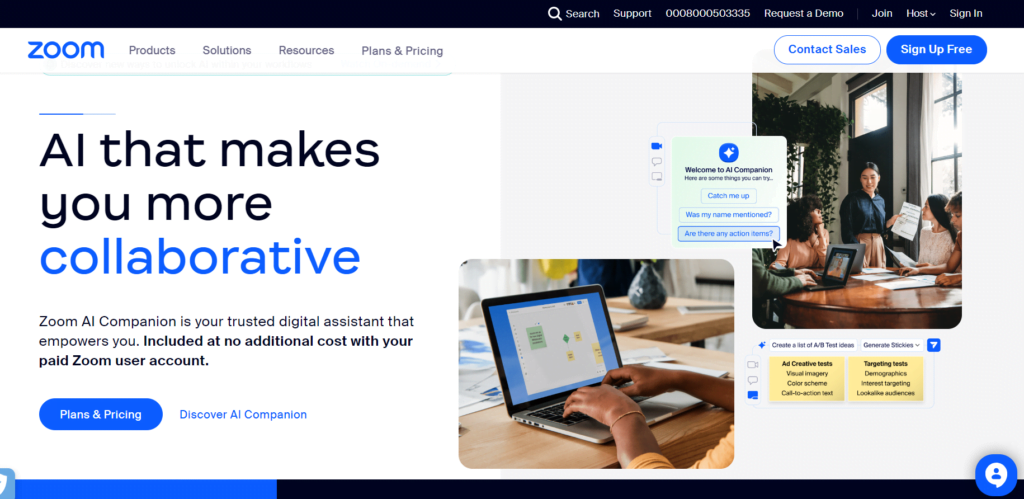
Zoom has emerged as a cornerstone in the realm of video conferencing, revolutionizing remote communication and collaboration. It provides a comprehensive platform for virtual meetings, webinars, and collaborative sessions, making it an essential tool for businesses, education, and personal use.
One of Zoom’s major USP is its high-quality video and audio capabilities. The platform delivers crisp visuals and clear sound, even in low-bandwidth environments, ensuring a smooth and immersive communication experience. This reliability has contributed significantly to Zoom’s widespread adoption for both professional and personal virtual interactions. Zoom has proven itself one of the best remote work tools especially in times of COVID.
The ease of use is a hallmark of Zoom’s design. Setting up or joining a meeting is straightforward, with users able to participate through various devices, including desktop computers, laptops, tablets, and smartphones. This device flexibility enhances accessibility and accommodates diverse user preferences.
One of Zoom’s distinguishing features is its virtual background capability. Users can choose virtual backgrounds, providing a professional and polished appearance to their video feeds. This feature adds a layer of personalization and professionalism to video calls, whether for business meetings or virtual social gatherings.
– Pros:
– High-Quality Video: Provides reliable and high-quality video conferencing.
– Screen Sharing: Easy and effective screen sharing for presentations and collaborative work.
– Virtual Backgrounds: Fun features like virtual backgrounds for a professional look.
– Cons:
– Security Concerns: Faced some security issues in the past, but the company has been actively addressing them.
– Free Version Limitations: Some features are limited in the free version.
3. Project Management – Asana:
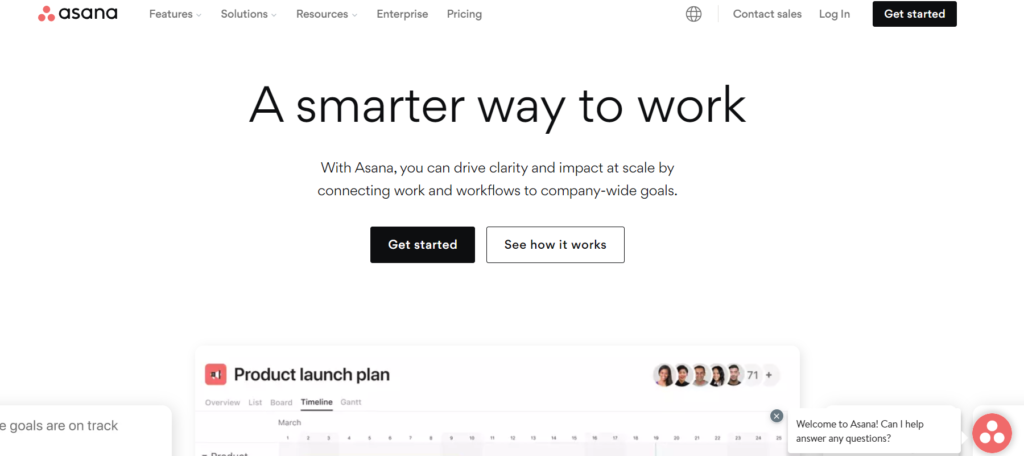
Asana stands out as a powerful and intuitive project management remote work tools designed to enhance team collaboration and streamline workflows. Renowned for its user-friendly interface and versatility, Asana provides a centralized platform for planning, tracking, and managing projects of varying complexities.
At its core, Asana employs a task-centric approach, allowing users to create tasks for specific activities, assign them to team members, set due dates, and attach relevant files or comments. Tasks can be organized within projects, providing a structured framework that aids in project clarity and progress tracking.
The platform’s flexibility is a notable strength. Asana accommodates different project management methodologies, including Kanban boards for visual task tracking and Gantt charts for timeline and dependency management. This adaptability makes it suitable for a wide range of projects, from simple to highly intricate.
Asana’s collaboration features foster transparency and communication. Team members can comment on tasks, attach documents, and mention colleagues, creating a dynamic and interactive workspace. Additionally, Asana enables users to view project timelines, track milestones, and manage resources effectively.
The tool’s integrations further enhance its functionality. Asana seamlessly connects with various third-party applications, such as Google Drive, Slack, and Microsoft Teams, enabling a cohesive work environment where information flows effortlessly between different platforms.
– Pros:
– Task Organization: Helps in organizing tasks, projects, and deadlines.
– Collaboration Features: Enables team members to collaborate on projects in real-time.
– User-Friendly Interface: User-friendly UI that is intuitive.
– Cons:
– Complex for Simple Tasks: Might be considered overly complex for very simple projects.
– Learning Curve: New users might need time to familiarize themselves with all features.
4. Document Collaboration – Google Workspace (formerly G Suite):
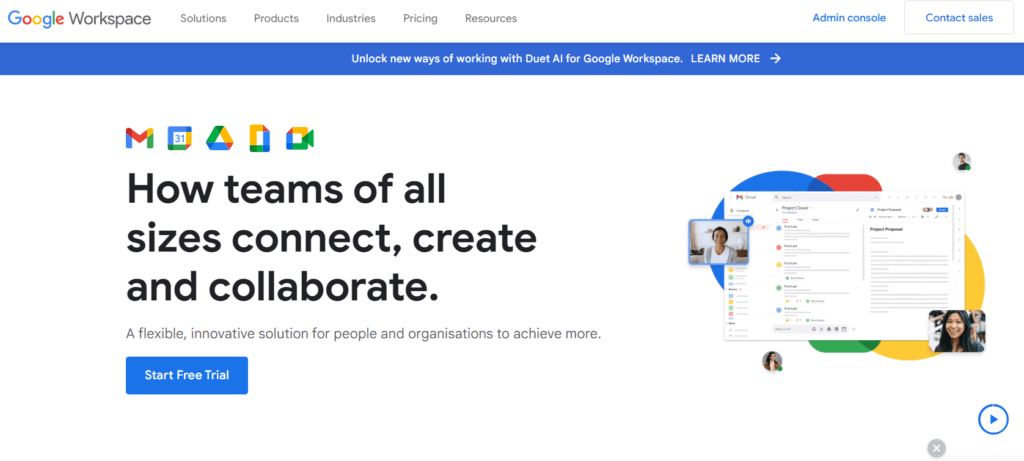
Google Workspace, formerly known as G Suite, is a pall- grounded tool package that facilitates flawless cooperation, communication, and productivity. With these features, Google Workspace has reinvented document collaboration. Google Workspace, with its emphasis on collaboration, offers a range of tools like as Google Docs, wastes, Slides, and more, revolutionizing the process of creating, editing, and participating documents among platoon members.
One of Google Workspace’s standout features is real-time collaboration. Multiple users can simultaneously work on a document, spreadsheet, or presentation, fostering an environment where ideas flow freely, and changes are visible in real time. This feature transcends geographical boundaries, allowing teams to collaborate effectively regardless of their physical locations.
Google Workspace operates in the cloud, offering the advantage of universal accessibility. Team members can access documents from any device with an internet connection, promoting flexibility and ensuring that work isn’t confined to a specific location or device. This cloud-centric approach simplifies document storage, retrieval, and sharing.
Google Workspace maintains an in-depth version history of documents, enabling users to monitor changes, go back to previous revisions, and recognize users. Additionally, the platform makes editing recommendations, which speeds up the review procedure by making it visible how suggested changes differ from previously posted data.
Google Workspace keeps a detailed version history of documents, allowing users to track changes, revert to previous versions, and identify contributors. The platform also offers editing suggestions, streamlining the review process by providing a clear distinction between proposed changes and existing content.
– Pros:
– Real-Time Collaboration: Users can work together on documents at the same time..
– Cloud Storage: Easy access to files from any device with cloud storage.
– Communication Integration: Seamless integration with Gmail and other Google services.
– Cons:
– Offline Limitations: Some features may be limited when working offline.
– Storage Costs: Additional storage beyond the free limit may incur costs.
5. Virtual Private Network (VPN) – Nord VPN:
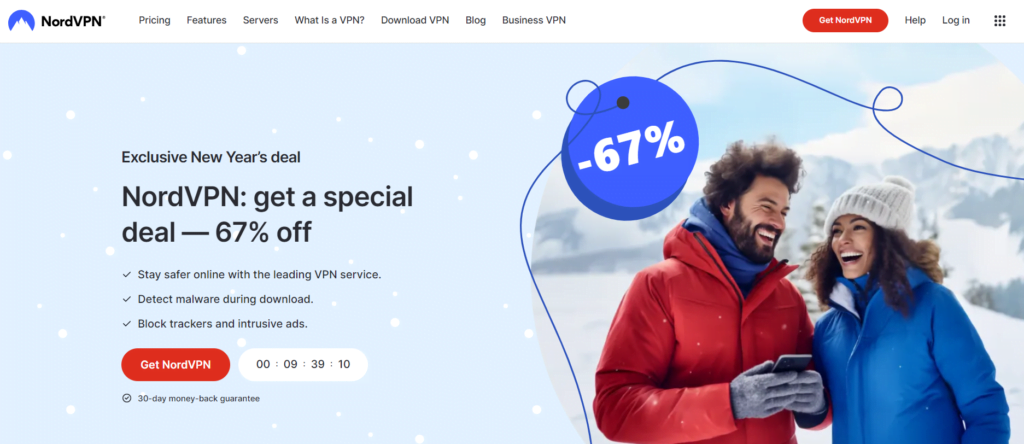
Leading virtual private network (VPN) provider Nord VPN is well-known for its dedication to provide customers a private and safe online experience. With its array of features that safeguard user data, guarantee anonymity, and facilitate safe internet browsing, Nord VPN has become a reliable defender in a time of cyberattacks.
Nord VPN employs state-of-the-art encryption techniques, including the widely respected AES-256-bit encryption. The confidentiality and security of data transferred over the internet are guaranteed by this military-grade encryption. The platform offers consumers choices to meet their individual needs by supporting many security protocols, including IKEv2/IPsec and OpenVPN.
Users can route their internet traffic through servers located in multiple regions with Nord VPN thanks to its extensive network of servers that covers numerous nations. By hiding the user’s IP address, this not only helps get over geographical content restrictions but also adds an additional layer of anonymity.
A standout feature of Nord VPN is its strict no-logs policy for it’s customer. The company follows a commitment policy of not storing user activity logs, ensuring that browsing history, connection timestamps, and other sensitive data remain private. This commitment to user privacy has been independently audited, reinforcing the platform’s transparency and trustworthiness.
– Pros:
– Security: Ensures a secure connection as a remote work tools, especially when accessing company networks.
– Global Server Network: Provides servers in various locations for improved accessibility.
– User-Friendly: Offers a user-friendly interface for easy setup.
– Cons:
– Subscription Cost: Requires a subscription, and the cost might be a consideration.
– Speed Variations: Connection speed may vary depending on the server location.
6. File Sharing and Collaboration – Dropbox:
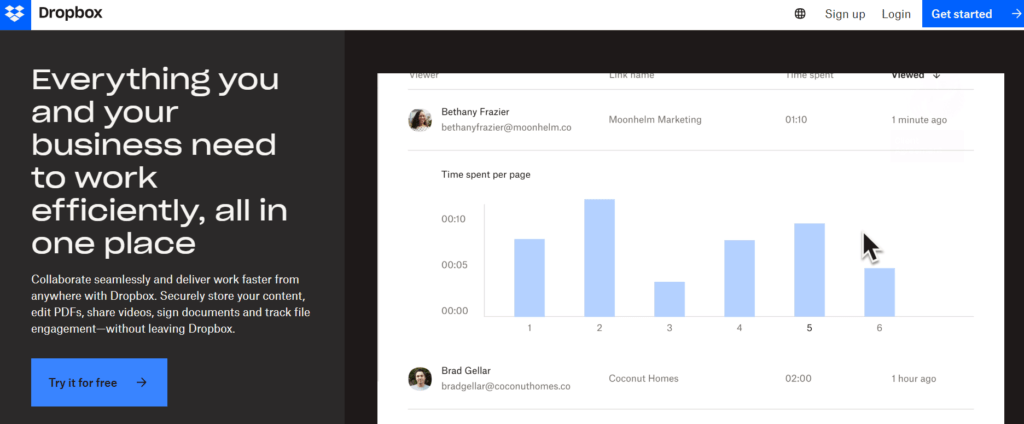
Dropbox’s cloud storage feature, which enables users to store files and retrieve them from any internet-connected device, is its core offering. This functionality guarantees that files are updated consistently across many platforms and also removes the requirement for actual storage devices.
Dropbox’s emphasis on collaboration is evident through its real-time editing and commenting features. Multiple users can collaborate on the same document simultaneously, facilitating instant feedback and enhancing teamwork. This functionality extends to various file types, including documents, spreadsheets, and presentations.
Sharing files and folders with Dropbox is a seamless process. Users can generate shareable links or invite collaborators directly to folders. Access permissions can be finely tuned, ensuring that users have the appropriate level of access for their role in a project.
Dropbox keeps track of all file versions and allows users to recover deleted files, roll back to earlier versions, and monitor changes. This versioning feature is particularly valuable for collaborative projects where changes may need to be revisited or undone.
Dropbox prioritizes the security of user data. It employs encryption protocols during data transmission and storage, and two-factor authentication adds an extra layer of protection. Additionally, users have control over sharing settings and can track access to their shared files.
– Pros:
– Ease of Use: Simple and user-friendly interface for file sharing and collaboration.
– Cross-Platform Access: Access files from various devices with ease.
– Version History: Keeps track of file versions for easy recovery.
– Cons:
– Limited Free Storage: The free version has limited storage, and additional space may require a subscription.
– Collaboration Features: Some collaboration features are more basic compared to other platforms.
7. Time Tracking – Toggl:
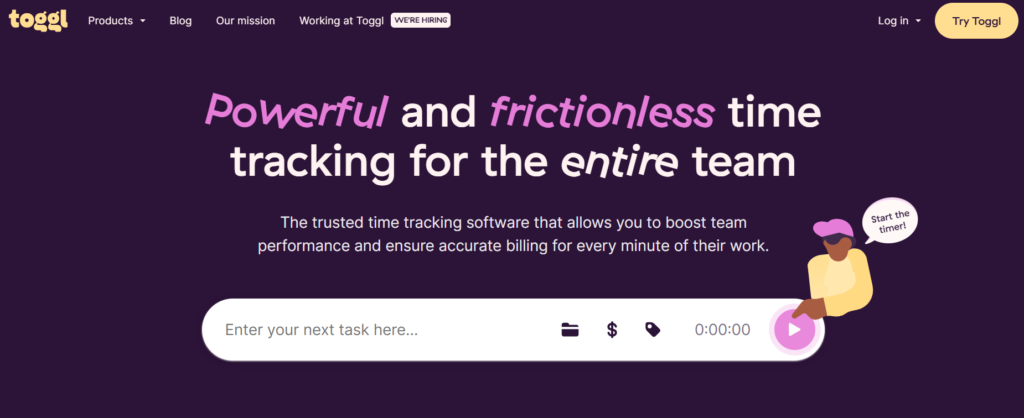
Toggl stands out as a versatile and user-friendly time tracking tool designed to empower individuals and teams with precise insights into their work hours. With its intuitive interface and robust features, Toggl is widely utilized by professionals across various industries to enhance productivity, monitor project timelines, and gain valuable time management insights.
Toggl simplifies the time tracking process with a straightforward and easy-to-use interface. Users can effortlessly start and stop timers, associating each tracked interval with specific tasks or projects. This simplicity encourages consistent and accurate time logging.
To facilitate project management, Toggl allows users to categorize time entries by projects and tasks. This organization is particularly beneficial for teams working on multiple projects simultaneously, providing a clear breakdown of time allocation across different endeavors.
Toggl goes beyond basic time tracking by offering robust reporting and analytics tools. Users can generate detailed reports, visualizing their time data in various formats such as charts and graphs. This analytical capability aids in identifying patterns, optimizing workflows, and making informed decisions based on time-related insights.
For freelancers and businesses offering services, Toggl simplifies client billing by providing detailed time logs that can be directly used for invoicing. This feature streamlines the billing process and ensures accurate compensation for services rendered.
– Pros:
– Simple Interface: Easy-to-use interface for tracking work hours and projects.
– Reporting Features: Generates detailed reports for better time management.
– Integration Capability: Integrates with various project management tools.
– Cons:
– Learning Curve: New users may need some time to get used to the features.
– Free Version Limitations: Some advanced features are available only in the paid version.
8. Note-Taking and Organization – Evernote:
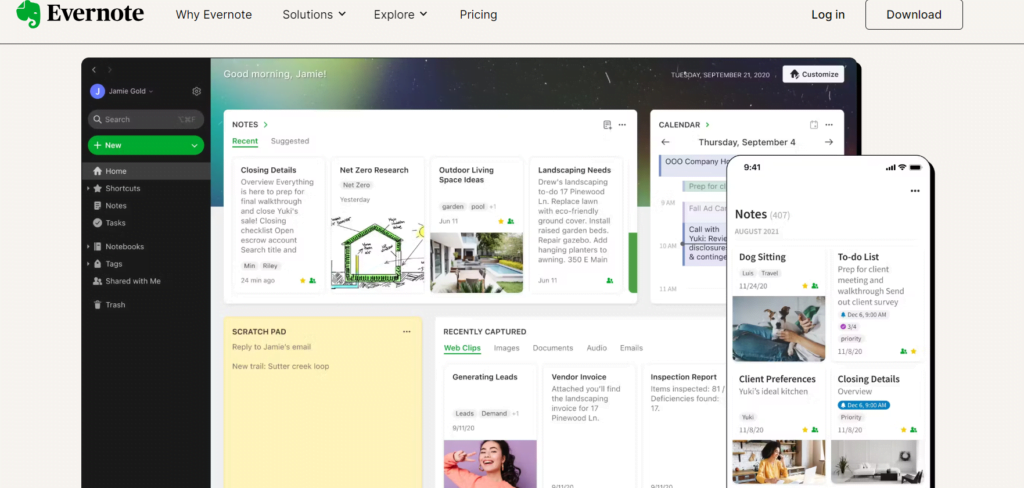
Evernote is a complete tool for storing, storing and synchronizing large amounts of data. It is useful for taking notes and organizing your life. Known for its adaptability, Evernote has grown into a versatile tool that helps users effectively manage concepts, tasks, and private information. It has beyond the realm of simple note-taking.
Basically, Evernote offers a digital note-taking surface. Users can create text notes, upload images, record audio, and even clip web articles directly into their Evernote notebooks. This flexibility allows for the seamless capture of diverse types of information in a centralized location.
To enhance organization, Evernote employs a system of notebooks and tags. Users can categorize and classify their notes into different notebooks, while tags provide a granular way to label and search for specific information. This hierarchical organization makes retrieval and categorization intuitive.
With Evernote’s offline note access feature, users may access, view, and edit their material without the need for an internet connection. This feature ensures that users can remain productive, irrespective of their current connectivity status.
Evernote prioritizes the security of user data. It employs encryption and multi-factor authentication to safeguard information. For an additional degree of security, users can also set passcodes on their mobile devices.
– Pros:
– Cross-Platform Sync: Sync notes across different devices for seamless access.
– Organization Features: Tagging, notebooks, and search capabilities for efficient organization.
– Collaboration: Share notes and collaborate with team members.
– Cons:
– Limited Free Version: Some advanced features are limited in the free version.
– Interface Complexity: The abundance of features may be overwhelming for some users.
9. Customer Relationship Management (CRM) – Salesforce:
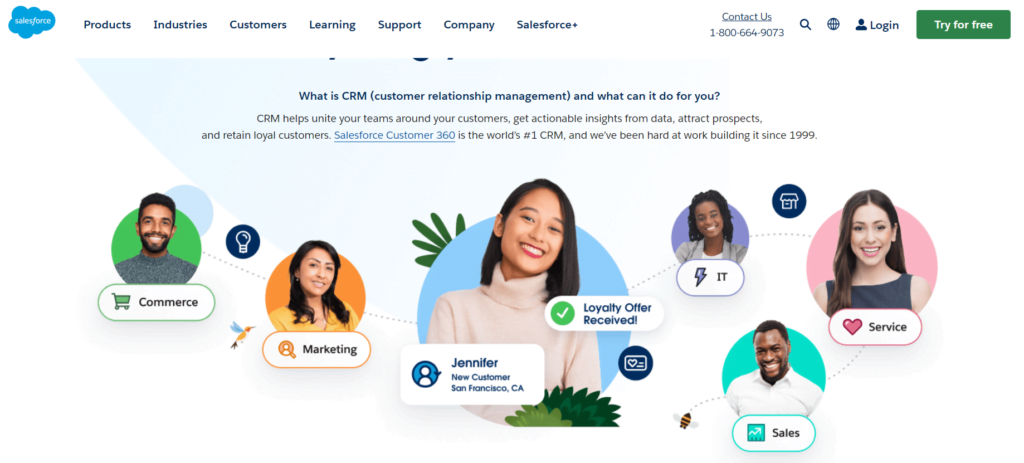
Salesforce is a cloud-based customer relationship management (CRM) software that has completely transformed the way companies make relationship with the customers and optimize different parts of marketing, sales and customer support functions. Salesforce, a leading provider of cloud-based customer relationship management (CRM) solutions, provides a wide range of tools and services to improve customer interactions and accelerate business growth.
The Sales Cloud module helps organizations manage their sales processes efficiently. It includes features for lead management, opportunity tracking, forecasting, and collaboration among sales teams. Salesforce automation tools reduce manual tasks, enabling sales teams to focus on building relationships and closing deals.
Service Cloud is designed in a way to enhance customer support and service. It includes tools for case management, knowledge base creation, and omni-channel support. Service agents can respond to customer inquiries through various channels, ensuring a seamless and personalized support experience.
Salesforce integrates artificial intelligence (AI) through its Einstein platform. Einstein provides predictive analytics, automation, and smart insights to help users make data-driven decisions and enhance productivity.
Salesforce’s platform allows organizations to build custom applications tailored to their unique needs. AppExchange, Salesforce’s marketplace, offers a vast ecosystem of pre-built apps and integrations that can be easily added to extend platform functionality.
– Pros:
– Comprehensive CRM: Offers a wide range of CRM functionalities.
– Customization: Extremely adaptable to meet unique company requirements.
– Analytics: Provides robust analytics and reporting tools.
– Cons:
– Complexity: The extensive features may be overwhelming for smaller businesses.
– Cost: Higher cost compared to some other CRM solutions.
10. Employee Engagement – TINYpulse:
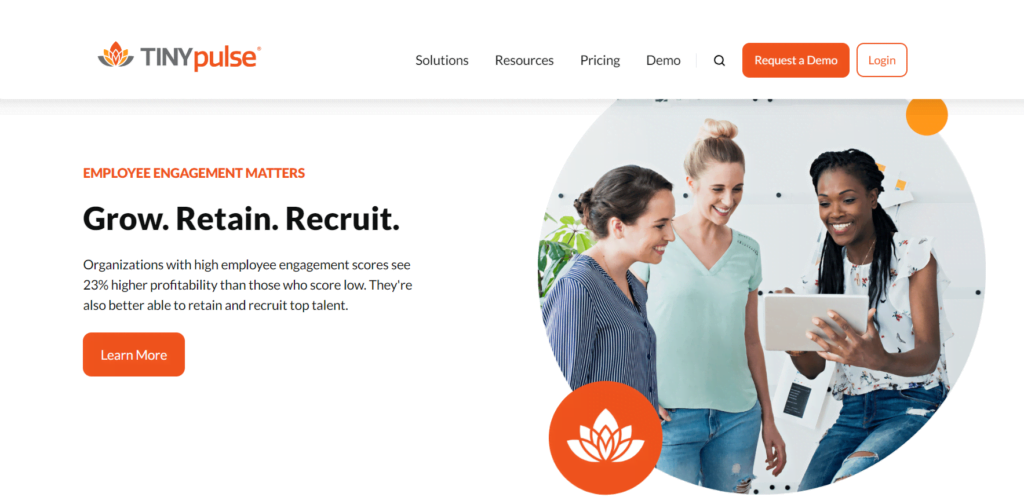
TINYpulse is an employee engagement platform designed to help organizations gather feedback, measure employee sentiment, and foster a positive workplace culture. These surveys often include questions related to job satisfaction, work-life balance, and other aspects of the workplace. TINYpulse offers a range of features that empower organizations to understand and enhance the employee experience through regular feedback and actionable insights.
The platform includes a feature called “Cheers” where employees can recognize and appreciate their colleagues for their contributions. This social recognition fosters a positive and collaborative work environment.
TINYpulse provides various channels for employees to share their thoughts and ideas. This can include suggestions for improvement, innovative ideas, or concerns, creating a platform for continuous dialogue.
TINYpulse employs sentiment analysis to gauge the overall mood and sentiment within the workforce. This helps organizations understand how employees feel about their work, colleagues, and the company culture.
Organizations can track performance metrics and trends over time using TINYpulse analytics. This feature allows leaders and managers to identify patterns, areas of improvement, and success stories within the organization.
– Pros:
– Feedback System: Facilitates employee feedback and engagement.
– Pulse Surveys: Conducts regular surveys to gauge employee satisfaction.
– Recognition Features: Allows for employee recognition and rewards.
– Cons:
– Feature Overload: Some organizations may find certain features unnecessary.
– Cost: The pricing model may not be suitable for smaller businesses.
11. Task Management – Todoist:
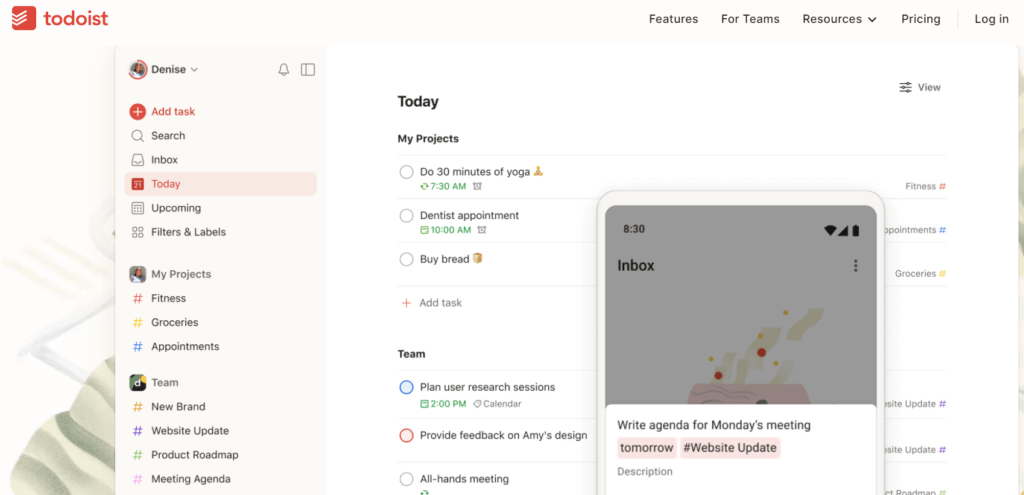
Todoist is a well-liked productivity and task management program made to assist both people and groups in planning, setting priorities, and working together on assignments and projects. Todoist, which is well-known for being straightforward and adaptable, provides a user-friendly design along with a number of tools to make maintaining to-do lists and accomplishing both personal and business goals easier.
Users can easily create tasks within Todoist, adding details such as due dates, priorities, and project labels. Tasks can be organized into projects, making it straightforward to manage multiple workstreams or personal activities.
Todoist allows users to assign priority levels to tasks, helping them focus on what needs immediate attention. Priority levels range from low to high, allowing for a quick visual assessment of task urgency.
It enables users to share tasks and projects with friends and coworkers, Todoist promotes collaboration. Collaborators can view and update shared tasks, fostering teamwork and coordination.
Todoist incorporates a gamification element with its Karma feature. Users earn Karma points for completing tasks and maintaining a productive workflow. This motivational aspect encourages users to stay consistent in their task management.
– Pros:
– Simple Interface: User-friendly interface for creating and managing tasks.
– Cross-Platform Sync: Sync tasks across devices for accessibility.
– Productivity Features: Includes features like due dates, labels, and priority levels.
– Cons:
– Advanced Features Limited: Some advanced features are only available in the premium version.
– Learning Curve: New users may need time to explore all functionalities.
12. Collaborative Whiteboard – Miro:
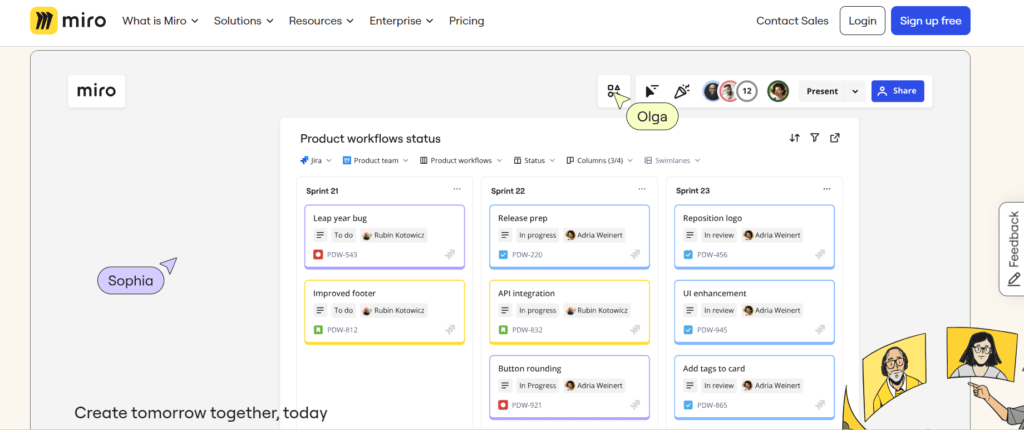
Miro is an online collaborative platform that serves as a digital whiteboard, empowering teams to ideate, plan, and collaborate visually in real-time. With its versatile set of tools and features, Miro facilitates remote collaboration and enhances creativity by providing a shared space for teams to work together visually.
Miro’s digital whiteboard provides a canvas where users can draw, write, add sticky notes, and create visual elements. It serves as a dynamic space for brainstorming, planning, and organizing ideas.
One of Miro’s standout features is real-time collaboration. Team members can work together on the same board simultaneously, regardless of their geographical locations. Changes made by any user will be instantly visible others.
Miro is well-suited for facilitating remote workshops and collaborative sessions. Whether it’s running retrospectives, design sprints, or strategy sessions, Miro provides a virtual space for teams to engage in structured activities.
– Pros:
– Real-Time Collaboration: Collaborate with team members on a virtual whiteboard.
– Templates: Provides various templates for different collaborative activities.
– Integration Capability: Integrates with other collaboration tools.
– Cons:
– Learning Curve: New users might take time to get used to the interface.
– Subscription Cost: Some advanced features are part of the paid plans.
13. Virtual Collaboration Space – Trello:
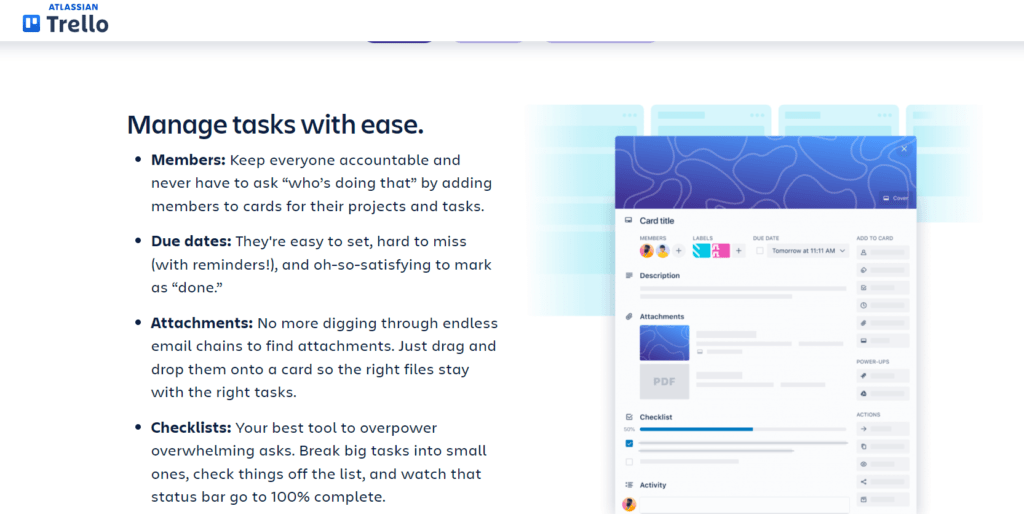
Trello is a popular project management tool that utilizes a visual and flexible approach to help individuals and teams organize tasks, projects, and workflows. Known for its simplicity and adaptability, Trello uses boards, lists, and cards to provide a visual representation of work, fostering collaboration and transparency.
Trello’s fundamental structure revolves around boards, which represent projects or initiatives. Within boards, users create lists to categorize tasks, and individual tasks are represented as cards. This visual hierarchy makes it easy to organize and prioritize work.
Trello’s intuitive drag-and-drop functionality allows users to easily move cards between lists, rearrange priorities, and update task status. This fluidity simplifies task management and reflects real-time changes.
Users can attach files, links, and relevant documents directly to Trello cards. Additionally, the platform supports comments, enabling collaboration and discussion on specific tasks or projects.
Trello is accessible on mobile devices through its app, allowing users to manage tasks, checklists, and boards while on the go. This mobile accessibility promotes flexibility and ensures teams can stay connected.
– Pros:
– Visual Project Management: Utilizes boards, lists, and cards for an intuitive project management approach.
– Customizable: Easily adaptable to various workflows with drag-and-drop functionality.
– Integration: Integrates with many other productivity tools.
– Cons:
– Limited Complexity: May not be suitable for very complex project management needs.
– Dependency Tracking: Advanced dependency tracking features are limited.
14. Time Zone Management – World Time Buddy:
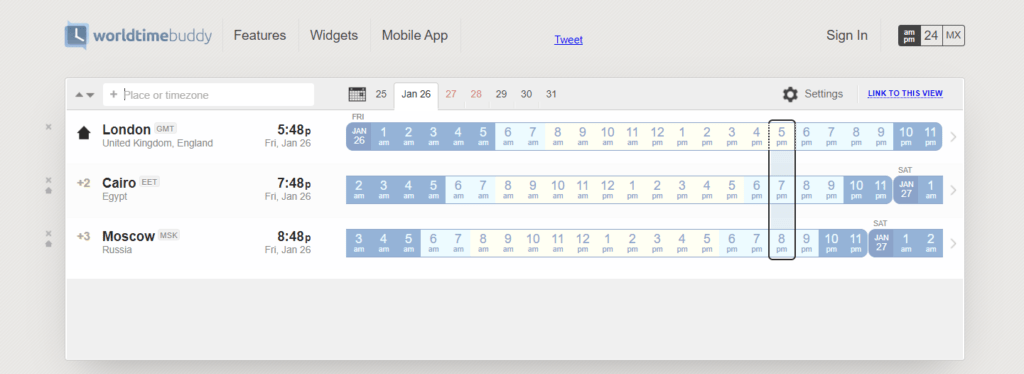
World Time Buddy (WTB) is a time zone management and scheduling tool that simplifies coordination across different time zones. WTB is a visual representation of overlapping and non-overlapping working hours that is intended for individuals and teams working cooperatively throughout the world. This feature facilitates the scheduling of meetings and the coordination of activities across several time zones.
WTB displays a visual time zone chart that presents multiple time zones side by side. This visual representation helps users quickly identify the current time in various locations and understand the overlap of working hours. The platform includes an integrated world clock that allows users to add and customize locations. This feature provides at-a-glance information about the current time in different parts of the world.
WTB automatically adjusts for Daylight Saving Time, ensuring accurate time calculations even when regions observe different time zone offsets during specific periods of the year. Users can set and customize their working hours on WTB. This information is then incorporated into the visual chart, helping teams identify common working hours for collaboration.
– Pros:
– Easy Time Zone Conversion: Quickly convert and compare multiple time zones.
– Meeting Scheduler: Helps in finding suitable meeting times across different time zones.
– Intuitive Interface: User-friendly interface for efficient time management.
– Cons:
– Limited Features: Some advanced features may not be available in the free version.
– Dependency on Internet: Requires an internet connection for real-time updates.
15. Employee Wellness – Headspace:
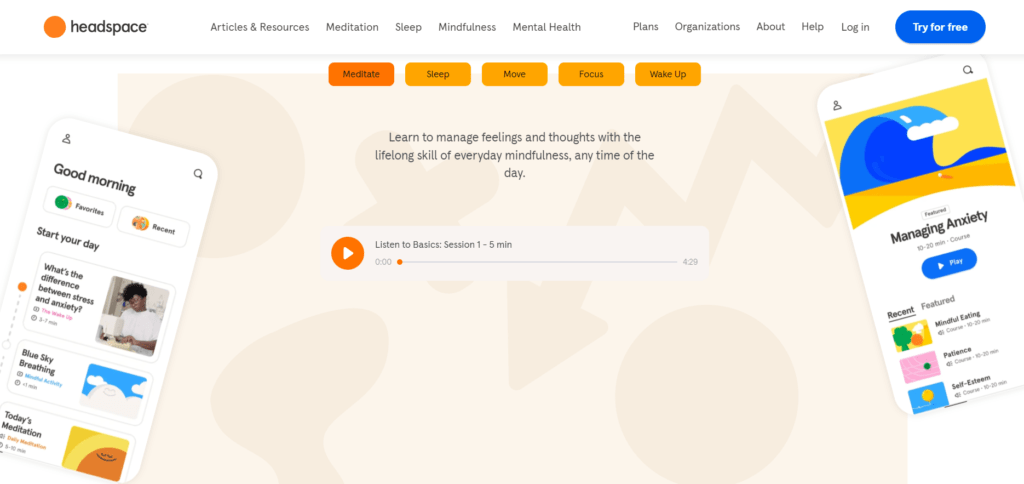
The goal of the well-known mindfulness and meditation app Headspace is to assist users in developing a more thoughtful and health-conscious way of living. Headspace is an app that was created by former Buddhist monk Andy Puddicombe and mindfulness expert Rich Pierson. It offers a range of mindfulness and meditation exercises to help users reduce stress, sharpen their attention, and feel better all around.
A wide variety of guided meditation sessions, tailored to certain elements of wellbeing, are available from Headspace. These sessions cover themes such as stress reduction, sleep improvement, focus enhancement, and more. The app includes short mindfulness exercises that can be incorporated into daily routines. These exercises are designed to bring attention to the present moment, fostering mindfulness in various activities.
For moments of acute stress or anxiety, Headspace provides “SOS” meditations — short, focused sessions aimed at providing immediate relief and helping users regain a sense of calm. Headspace offers a collection of soothing sounds and bedtime stories designed to improve sleep quality. These features contribute to creating a peaceful and relaxing bedtime routine. The app includes guided exercises for mindful movement, such as walking or stretching, encouraging users to bring awareness to their bodies and movements.
– Pros:
– Mental Health Support: Provides guided meditation and mindfulness exercises.
– Stress Reduction: Aims to reduce stress and improve overall well-being.
– Accessibility: Accessible from various devices.
– Cons:
– Subscription Cost: Premium features require a subscription.
– Personal Preference: Effectiveness may vary depending on individual preferences.
16. Expense Management – Expensify:

A cloud-based platform for managing expenses called Expensify makes it easier for both people and companies to keep track of, submit, and reimburse their costs. Expensify strives to reduce time spent on expenditure reporting by emphasizing automation and user-friendly features.
Expensify employs Optical Character Recognition (OCR) technology to extract information from receipts. Users can simply take pictures of their receipts using the mobile app, and Expensify automatically captures and categorizes relevant details. Expensify offers automatic tracking of expenses by connecting to users’ bank accounts and credit cards. This feature helps users stay up-to-date on their spending without manual data entry.
Users can easily create detailed expense reports within the Expensify platform. The system consolidates individual expenses, adds necessary details, and formats the report for submission.
Expensify’s SmartScan technology enhances receipt scanning by automatically categorizing expenses and associating them with the correct accounts. This reduces the manual effort required for expense categorization.
For users with corporate credit cards, Expensify can automatically reconcile expenses with corporate card transactions. This helps in accurately tracking and managing corporate card expenses. For businesses operating globally, Expensify provides support for multiple currencies. Users can submit expenses in different currencies, and the platform handles the conversion and reporting seamlessly.
– Pros:
– Receipt Scanning: Streamlines expense reporting with receipt scanning.
– Integration: Integrates with various accounting and finance tools.
– Policy Compliance: Helps ensure compliance with company expense policies.
– Cons:
– Learning Curve: Users might need time to familiarize themselves with all features.
17. Remote Team Building – Donut:
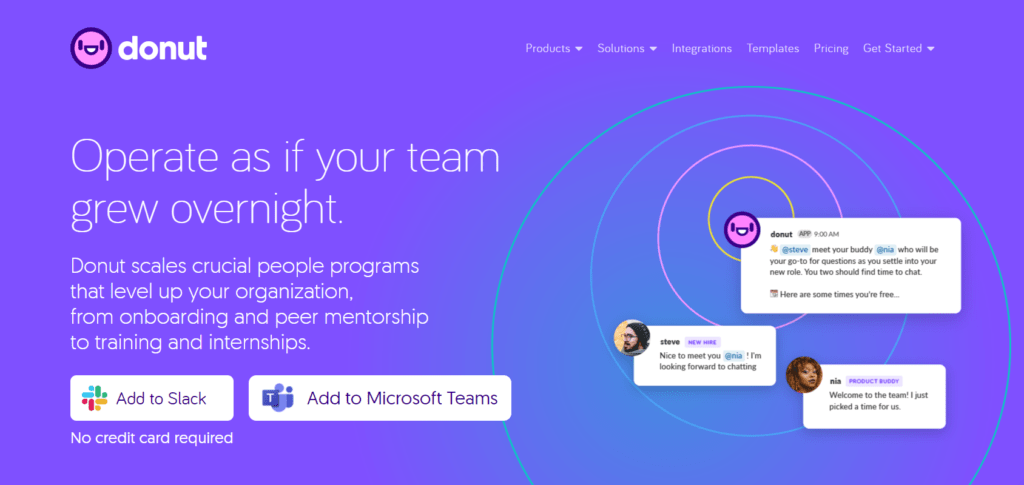
Donut is a virtual team-building tool designed to enhance connections and camaraderie among remote team members. The app facilitates random pairings of team members for virtual coffee or chat sessions, creating opportunities for casual conversations and relationship-building.
How Donut Works:
- Random Pairings: Donut randomly pairs team members at regular intervals, such as weekly or bi-weekly, creating an element of surprise and encouraging interactions among colleagues who may not regularly engage.
- Virtual Coffee or Chat Sessions: Once paired, team members can schedule virtual coffee meetings or chat sessions. These interactions are informal and provide a relaxed environment for team members to get to know each other beyond work-related discussions.
- Icebreaker Questions: Donut often includes icebreaker questions or conversation prompts to make the virtual meetings more engaging. These questions can range from personal interests to fun hypothetical scenarios, sparking interesting and lighthearted discussions.
- Integration with Communication Platforms: Donut integrates with popular communication platforms such as Slack and Microsoft Teams. This seamless integration allows team members to receive notifications and manage their Donut interactions within the platforms they already use for work.
– Pros:
– Virtual Coffee Chats: Facilitates random pairings for virtual coffee chats among team members.
– Icebreaker Questions: Includes icebreaker questions to spark conversations.
– Easy Integration: Integrates with Slack for seamless communication.
– Cons:
– Dependence on Slack: Requires a Slack workspace for integration.
– Limited Structured Activities: More informal, might not suit teams looking for structured team-building activities.
18. Team Building and Recognition – Bonusly:
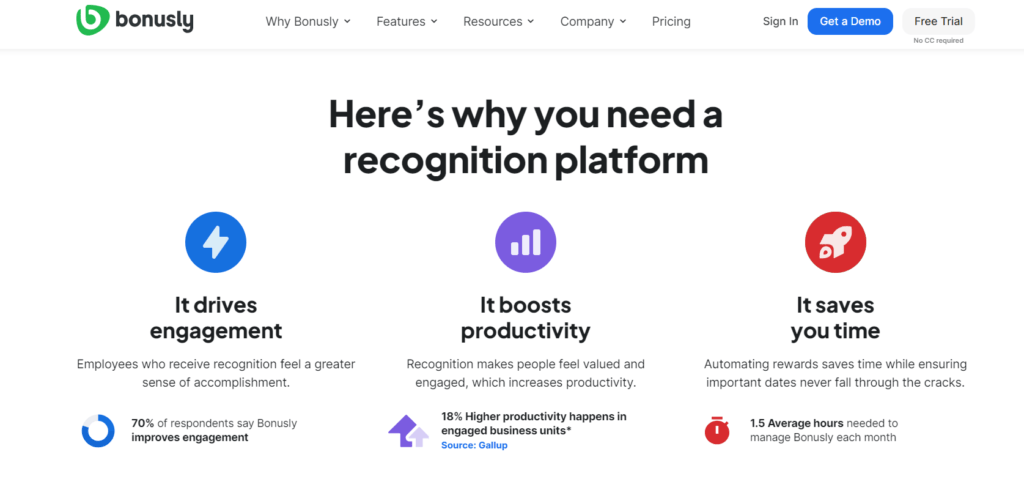
Bonusly is an employee recognition and rewards platform designed to foster a positive workplace culture by encouraging peer-to-peer recognition. It gives a place for employees to express appreciation to one another in the form of “Bonuses,” which are points that can be exchanged for various kinds of incentives. Bonusly aims to enhance employee engagement, boost morale, and reinforce a culture of appreciation within organizations.
Bonusly emphasizes peer-to-peer recognition, allowing employees to recognize and appreciate their colleagues for their contributions. This creates a culture of acknowledgment and appreciation within the organization. Users can customize the reasons for giving bonuses, tailoring recognition to specific achievements, behaviors, or values that align with the organization’s goals. This flexibility ensures that recognition is meaningful and aligned with company values.
The platform includes a real-time recognition feed where employees can see and celebrate the achievements and recognition given to their colleagues. This creates a transparent and positive communication channel within the organization.
Bonusly provides analytics and reporting features that offer insights into recognition trends, employee engagement, and the impact of recognition efforts. This data can be valuable for HR and leadership in assessing the effectiveness of the recognition program.
– Pros:
– Recognition Platform: Facilitates peer-to-peer recognition and rewards.
– Customizable: Allows organizations to customize reward programs.
– Integrations: Integrates with various collaboration tools.
– Cons:
– Subscription Cost: Premium features require a subscription.
– Subjectivity: Effectiveness may vary based on organizational culture.
19. Task Automation – Zapier:
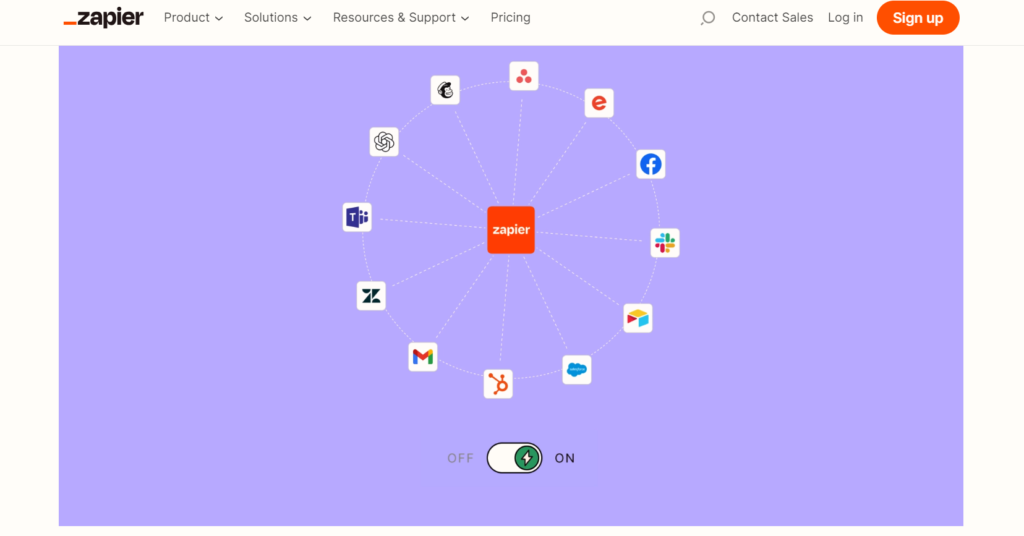
Zapier is a web-based automation tool that connects various apps, services, and platforms to automate workflows. It enables users to create automated workflows, known as “Zaps,” by linking different applications and automating repetitive tasks without the need for coding skills. Zapier supports a wide range of apps, making it a versatile tool for individuals and businesses looking to streamline their processes.
Zapier supports integration with thousands of apps, spanning categories such as productivity, communication, project management, CRM, and more. This allows users to connect and automate workflows across diverse platforms. Zaps are created based on triggers and actions. Triggers initiate the automation when a specified event occurs in one app, and actions are the subsequent steps taken in response to the trigger in another app.
Zaps can be configured to perform actions instantly or with a delay. Delayed actions are useful for scenarios where a timed response is required, such as sending follow-up emails after a set period. Some Zaps include a search action, allowing users to look up information from one app and use it to perform actions in another. This is particularly useful for managing data and ensuring accuracy.
Zapier provides error handling features to address issues that may arise during automation. Users can set up notifications for errors and implement fallback actions to manage exceptions. Zapier supports team collaboration by allowing users to share and collaborate on Zaps. This is beneficial for teams working on common processes and wanting to collectively manage automation workflows.
– Pros:
– Automation: Automates repetitive tasks by connecting different apps.
– Wide App Integration: Supports integration with a vast array of apps and tools.
– Customizable Workflows: Allows users to create custom automation workflows.
– Cons:
– Learning Curve: Requires understanding of automation logic.
– Subscription Cost: Some advanced features are part of the paid plans.
20. Passwordless Authentication – YubiKey:
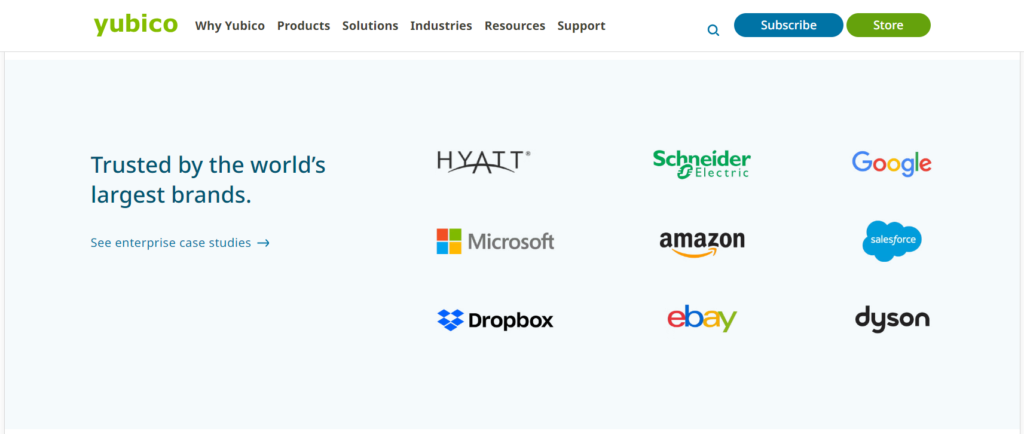
YubiKey is a hardware authentication device developed by Yubico, providing an additional layer of security for online accounts, applications, and systems. It is a small, physical USB or NFC (Near Field Communication) device that users can insert or tap to authenticate their identity securely. YubiKey supports various authentication protocols and is widely used for two-factor authentication (2FA) and multi-factor authentication (MFA).
YubiKey serves as a physical security key, adding a tangible element to the authentication process. It is designed to be resistant to phishing attacks and other online threats. Users can authenticate with a single touch or tap by inserting the YubiKey into a USB port or tapping it against an NFC-enabled device.
YubiKey supports multiple authentication protocols, including Universal 2nd Factor (U2F), FIDO2, Yubico OTP (One-Time Password), and others. This versatility allows it to be used with a wide range of applications and services.
YubiKey is commonly used for two-factor authentication, requiring users to provide something they know (password) and something they have (YubiKey) for secure access. With support for FIDO2, YubiKey enables passwordless authentication. Users can authenticate without entering a password, enhancing security and convenience.
– Pros:
– Enhanced Security: Provides an additional layer of security beyond passwords.
– Easy to Use: Simple physical device for authentication.
– Compatibility: Works with various platforms and services.
– Cons:
– Cost: Requires purchasing physical YubiKey devices.
– Dependency on Physical Device: Losing the YubiKey could cause access issues.
We really hope these remote working tools review will be helpful to you. Do let us know your thought on this.
